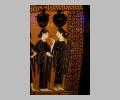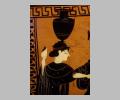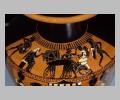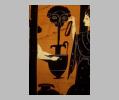| Collection: | Toledo Museum of Art |
| Summary: | Main scene: women at a fountain-house, shoulder: warriors departing. |
| Ware: | Attic Black Figure |
| Painter: | Attributed to the Priam Painter |
| Date: | 520 BC - 510 BC |
| Dimensions: | H. to top of handle 58.5 cm., H. to rim 54.0 cm., D. of rim 27.0 cm., D. of shoulder 33.6 cm., D. of foot 17.0 cm. |
| Primary Citation: | |
| Shape: | Hydria |
| Beazley Number: | 351088 |
| Period: | Archaic |
Decoration Description:
Main scene: Women at a fountain-house. The fountain-house appears in the center of the picture and is represented by two Doric columns with an entablature and roof. Inside the fountain-house is a lion's-head spout, shown frontally, from which issues a stream of water. Six women appear: (from the left) 1, balances a hydria on her head and moves to the left while she looks back to her right at the others; 2, holds an empty hydria crosswise on her head, grasping the vertical handle with her left hand as she looks at 3, who looks back to the left at 2 and steps inside the fountain-house, bending forward to hold the horizontal handles of her hydria as it is being filled with water from the spout. On the floor of the fountain-house is a kalpis, presumably belonging to 4, who moves to the right, but looks back to the left and holds a fillet in her raised right hand; 5 and 6, with hydria and kalpis balanced on their heads, stand to the right in conversation, with 6 looking back at 5. Each of the women wears a peplos and himation, except for figure 3, who wears a peplos only. Each wears a fillet except for figure 4, who wears a sakkos and carries her fillet in her hand. The sides of the left-hand column of the fountain-house are outlined with incision. Regulae, each with three guttae, appear on the underside of a shallow architrave. Above the architrave is a frieze of alternating narrow black and broad white spaces, indicating triglyphs and metopes. The frieze begins with a triglyph at the left, and ends with a metope at the right. Above the shallow cornice is a low pediment. Added red: The fillets worn by figures 1, 2, 3 and 5, and the dots on the garments of all six figures. Added white: The regulae, metopes and the roof of the fountain-house, and dotted triplets and quadruplets (the latter with incised crosses) on the garments of all figures.
Shoulder: Warriors departing. A charioteer (second from the right) mounts a chariot to the left. An archer, standing behind the horses, looks right and raises his left hand in a gesture to the warrior at the extreme right of the scene, who moves to the right, but looks back to the left. To the left of the horses an old man sits on a block and gestures toward them with his upraised right arm. At the far left is another warrior moving towards the right. The figure at the far left wears a low-crested Corinthian helmet, corslet, short chiton, baldric, greaves and carries a Boeotian shield. The seated old man wears a himation. The archer has a cap, tunic, trousers (?), and crossed baldrics. The charioteer wears a long robe and a scabbard, and a Boeotian shield (device: a tripod) hangs on his back. The warrior on the far right wears a low-crested Corinthian helmet, corslet, short chiton, greaves, baldric and circular shield (device: a bull's head, caboshed). Added red: The borders of the shields, the breastbands of the horses, their manes, and part of the chariot. Added white: The baldric and arm-band and dots on the skirt of the chiton of the warrior at the far left; the hair and moustache of the old man and his seat cover; the baldrics and dotted quadruplet on the tunic of the archer; the robe and shield device of the charioteer; the baldric and shield device of the warrior on the far right.
There is a black tongue-pattern at the base of the neck. The main scene has a leftward key-pattern above, a double chain of lotus and palmette at its sides, and a chain of palmettes alternately upright and pendent below it. Added red appears on the outer faces of the rotelles, on the two bands below the main scene and on the single band above the rays at the base. For the graffito on the underside of the foot, cf.
Attributed to the Priam Painter by Beazley (ter). The Priam Painter is a particularly noted artist of the late phase of the black-figure technique (see BSA 36 (1935-1936) 152 ff.
Graffiti:
Graffito on the underside of the foot.
Essay:
Collection History:
Gift of Edward Drummond Libbey.
Sources Used:
Other Bibliography:
Toledo Museum News 5 (1962) 88Toledo Museum News 11 (1968) 50 and coverWissenschaftliche Zeitschrift der Universität Rostock 17 (1968) 642ter; Toledo Museum News 15 (1972) 68-69





